Nile Monitors
Nile monitors are one of Africa's largest reptiles; a lizard of potentially massive proportions that lives along riverbanks, streams, lakes, and ponds. They are found anywhere in Africa where there is water, from the Nile river delta in the north, crossing the Sahara along the course of the Nile river, and from there extending as far south as the Cape of Good Hope in South Africa. They are adaptable, and do well in distrubed areas and will even enter towns to scavenge among the refuse heaps.
In appearace, the Nile monitor is slender but muscular. They have a robust triangular head with a bowed lower jaw. The neck is long with a distendable throat pouch; when not distended, the skin of the throat pouch hangs in folds about the neck and throat. The robust, powerful limbs have long digits tipped with large talons. The tail is long, longer than the rest of the body from nose to hips, thick and muscular near the base, tapering to a whiplash at the end, and keeled along most of its length. Their base color is typically grey or black with yellow or white spots. Some say they have a yellow-greenish cast to them, although I have never seen the green in them myself. The limbs are marked with spots; hash marks extending across the upper and lower jaws obscure the opening of the mouth; a dark stripe goes through the eye and merges with a series of chevrons marching down the neck, which subsequently break up into spots crossing the back in distinct bands, which then merge into solid rings encricling the tail. The throat and sides are marked with distinct reticulations, and narrow dark lines cross a light colored belly. The tongue is long, narrow, forked, and dark blue or purple-blue in color. The adult size of this animal can range from a little less than a meter to up to two and a half meters. Exceptionally large Nile monitors can mass as much as 20 kilograms.
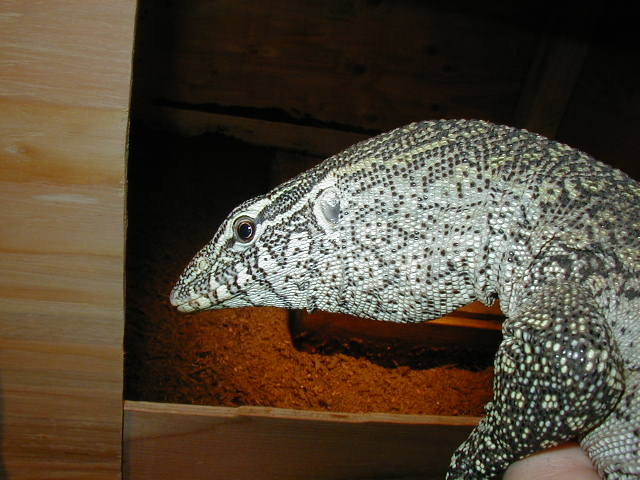
This Nile monitor is distending its throat pouch as part of a threat display. This shows it is nervous and wants to be left alone. Nile monitors, like all other monitors, also use their throat pouch to help them breathe. By pumping their pouch, they force air into their lungs, overcoming their lack of a diaphram. This lets them stay active for long periods of time without becoming tired.
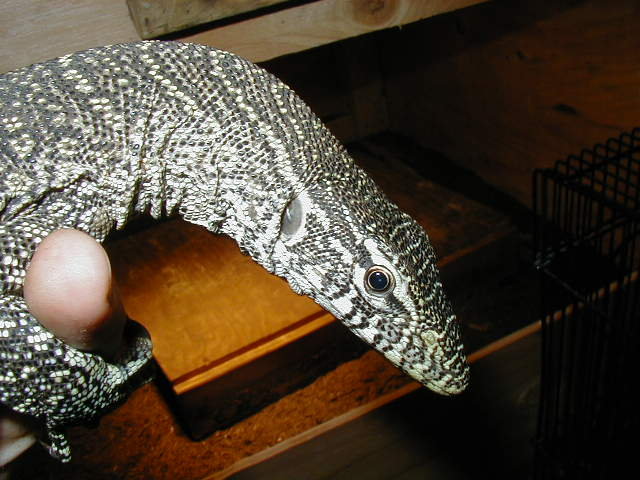
In this image, the throat pouch is retracted, showing the folds of skin around the neck.
In motion, the Nile monitor holds its body well above the ground with its legs. The neck is parallel to the ground, the mid parts and end of the tail drag upon the ground. At a leasurly pace, the body swings in a sinuous arc as the limbs are lifted well clear of the ground on each swing to be plopped back down for the propulsive stroke. The tongue flickers in and out of the mouth, testing the ground and air for scents. When in a hurry, the body is held stiffer as the lizard scampers for safety or towards a tasty morsel. In the water, the Nile monitor swims with a graceful serpentine motion, with most of the power coming from its long strongly keeled tail. The Nile monitor can climb well, its talons serving as hooks to catch branches and cracks in bark or rocks. With its impressive strength, it can even friction climb by clamping a smooth surface between its limbs and shimmying upwards, much as a person might climb a rope. Nile monitors are agile and good jumpers, and can leap for low lying ledges or branches. They are also powerful diggers, with their claws and strong forelimbs allowing them to rip through even hard packed and sun baked dirt or the concrete-like outer walls of termite mounds.
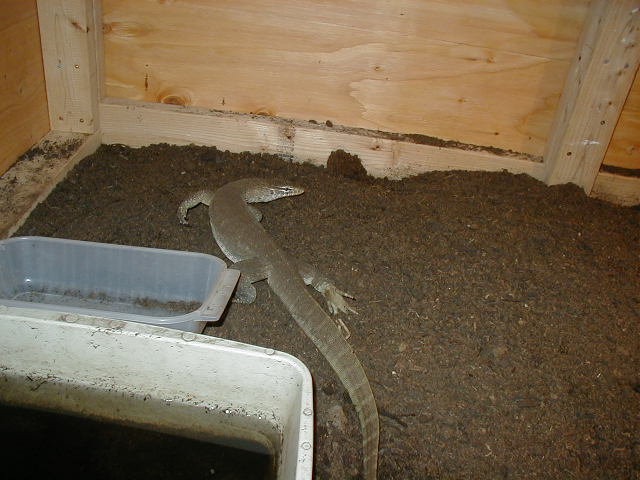
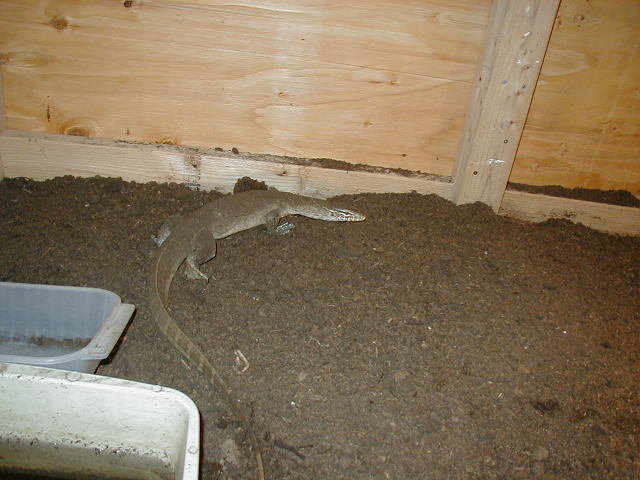
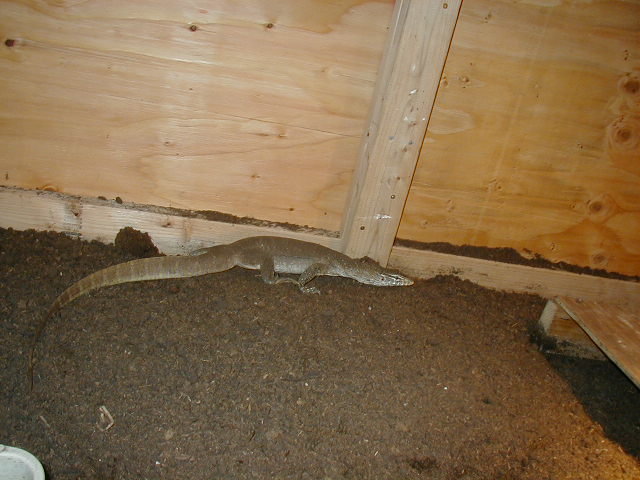
This series of images shows a Nile monitor walking.
Nile monitors have acute eyesight, and are quite capable of distinguishing between people by vision alone. They can spot potential enemies, prey, rivals, or mates from a long way away. Like most reptiles, Nile monitors have color vision, and can even see more colors than we can. However, their most remarkable sense is that of smell. Their probing tongue picks up scent particles from the air, the ground, or another surface, and presses these against a special organ on the roof of their mouths that analyzes the odors collected. Because the tongue is forked, the two tines can pick up scent gradients, and allow the monitor to know which direction the scent is strongest. They use their remarkable sense of smell to find prey, track mates, keep tabs on their neighbors, and warn them of approaching predators. A monitor's sense of hearing is not nearly so acute as that of most people, however. While they are quite sensative to low to mid frequencies, their rage of hearing is nowhere near so broad of that of mammals. They react to sounds in a very different way than mammals - loud sounds that would startle a mammal may be completely ignored by a monitor even though they can hear the sound quite clearly. If they learn to associate a sound with food, however, they will pay close attention when they hear it.
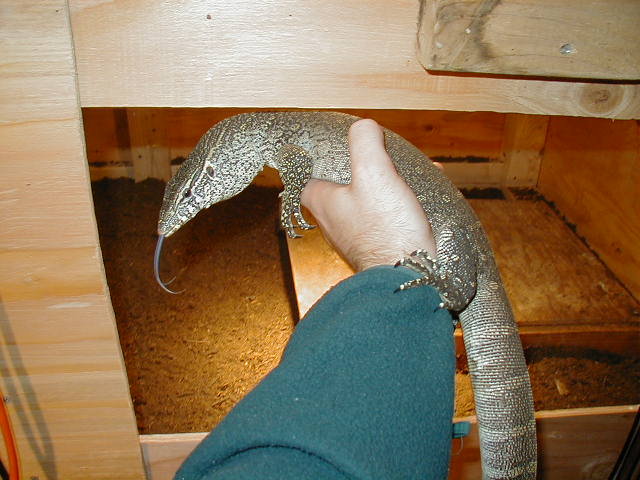
Here, a Nile monitor is shown in mid tongue-flick, displaying this remarkable sensory organ of the monitor lizards.
Nile monitors are opportunistic predators and scavengers. They eat nearly anything they can catch and stuff into their maws, from birds, lizards, snakes, and small mammals to fish, insects, and worms. Their powerful jaws can crush the shells of clams, snails, crayfish and crabs to get at the meat inside. In this, they share an adaptation in comon with most of the other African monitors but not found in monitors elsewhere in the world - the teeth become blunted and peg-like in the back of the jaws with age, to better handle the stresses involved with their crushing bites. The teeth in the front of the jaws, however, tend to remain sharp but conical, for holding struggling prey. Nile monitors are notorious egg theives, and while their depredations of chicken coops are unwelcome, their remarkable apetite for the eggs of the maneating Nile crocodile must win them friends in their native lands - one study showed that 95% of all crocodile nests lost had been plundered by Nile monitors. This is no small feat, since mother crocodiles guard their nests
fiercely, and a quarter to half ton crocodile is more than a match for a
2 to 10 kilogram monitor lizard. They will also consume carrion, even
really rank, maggoty carrion or dried up, mummified carcases. If the carcass is too big to swallow whole, the monitor will rip it into smaller pieces with claws and teeth.
A female Nile monitor can lay up to 60 eggs in a clutch, and if like most other species of monitors, can lay several clutches a year. These eggs are often deposited in termite mounds, but may also be layed in burrows dug in sun-warmed banks or other places with suitable temperatures, humidity, and soil composition. The youngsters hatch in 6 to 9 months and dig their way out. Without parental guidance from the get-go, the hatchlings may hang out in groups while they grow.
With their prolific breeding and adaptable habits, Nile monitors are in no danger of extinction. This is fortunate, since they are heavily exploited for the leather and pet trade. Indeed, the hatchlings are a staple of pet shops in the U.S., and can be found in large numbers at most reptile trade shows, with dozens of hatchlings stuffed into a glass terrarium prominently displayed on the tables of the larger and more undiscriminating vendors; as the baby monitors claw at the sides and climb over their cage-mates seeking shelter or escape.
This exploitation for the pet trade may actually be beneficial to the wildlife and people back in Africa, since it provides income to the needy farmers and thus incentive to preserve habitat that can support the monitors. However, Nile monitors are unfortunately quite unsuitable as pets. There are all the problems involved in caring for a very large, powerful, and active lizard that you get with any other monitor; but on top of that Nile monitors are usually exceedingly untrusting and defensive. They rarely come to accept the presence of their human owners, typically running to hide as soon as they see you. If approached, they will whip you with their tails, leaving welts and bruises on unprotected skin. If grabbed, they defend themselves with claws and teeth, and show no hesitation about emptying the contents of their bowels all over you.
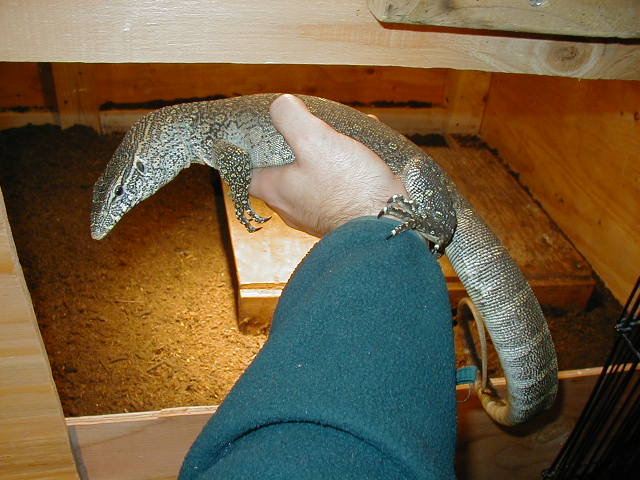
This picture shows a typical full threat display, with the throat pouch distended, the neck arched, and the tail coiled away from the monitor's antagonist. In this fashion, the tail is ready to lash out and strike any who venture too close, to try to get percieved attackers to keep their distance. Nile monitors have been known to lash their keepers across the eyes, a painful experience to say the least. This animal is a sub-adult, it will get a lot larger as it matures.
On the rare occasion that you get a Nile that comes to trust you, you can have a truely wonderful pet, but such a large animal needs a lot of work to give it the right home with the right heat and environment, and to keep that home (and especially the water dish) clean. Take this advice from a veteren monitor keeper, and do not let your Nile monitor have the run of your home. They are among the most reclusive of all the monitors, with a penchant for squeezing into tight, solid, and completely inaccessable places and refusing to come out. They can also be very destructive. They can dig right through drywall. They will climb your curtains and blinds, destroying them. They will climb your house plants, breaking off the stems and branches, knocking them over, and even digging out the soil. They will climb your shelves, knocking down books, collectables, or priceless china. They will wedge themselves behind shelves and push, causing the shelf to sway and once again knocking down books, collectables, and priceless china. They leave stinking, steaming piles of poop on your floor. A large and sturdy cage or a monitor-proofed room is a must.
The care of Nile monitors is practically identical to that of the argus monitors. The main difference is that Niles are semi-aquatic, and will spend more time swimming in their water dish. They are also better equipped for dealing with hard shelled prey, such as snails and crayfish. Niles don't dig quite so enthusiastically as arguses, although they do like to dig their own burrow and a deep dirt substrate that holds a burrow is still the best choice.
The difficulty of caring for a Nile monitor, the space they require, and their usually unfriendly attitude, combined with the low price and ready availability of the hatchlings, makes this lizard one of the most abused and neglected animals in the pet trade. Of that cage full of squirming youngsters at the trade shows, chances are that in a year not a single one will still be alive. Those that survive to adulthood are commonly offered to zoos, other reptile keepers, or given up for adoption to local humane societies or herp clubs. If you are thinking of keeping a Nile monitor, consider rescuing one of these adult unfortunates instead of propagating the importation of live hatchlings by the unscrupulous or misinformed pet stores and importers by giving your money to those who sell these animals for profit. The exception are those few who are attempting to pioneer the captive propagation of this species. These breeders cannot hope to make money at their hobby when importers can sell their wares at $10 a hatchling, so they operate at a significant loss for the love of the animals they keep. A true captive bred monitor is a better pet in every way - healthier and better adjusted to a captive life. Beware, however, for almost everyone who sells imported Nile monitors will claim their wares are captive bred. If you are looking for a captive bred juvenile, cut out the middle man and buy directly from the breeder. These days, this is possible with the internet, but be careful who you buy from, for con men and hucksters are all to willing to take your money and run. Demand proof in the form of photos of the eggs hatching, the parents depositing their eggs, or other such evidence, or do some research and find those breeders who are well known and respected. Unfortunately, there are very few breeders of Nile monitors, and it might be that no one trustworthy has any hatchlings at the time you are looking.
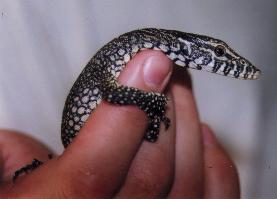
Nile monitors start out like this, cute little babies that can be obtained for low prices.
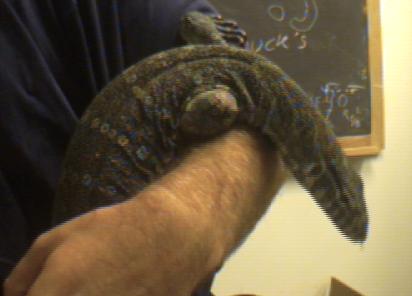
However, they soon grow into a large and powerful lizard that is usually very fearful of humans and willing to back up their distrust with teeth and claws. Even the few tame ones can be a real handful. The Nile monitor pictured is a mid sized individual, about a meter and a half long, some get much larger.
I have kept many Nile monitors, but only one was ever the slightest bit trusting. This was Cleo, a wonderful animal who captured my heart. I have her story online, click here to read it.
In case you are wondering, at this time I do not personally breed Nile monitors. I would love to try to work with this species to selectively breed a more docile, tractable animal better suited as a pet. However, given limited space and resources, I had to make a choice, and I decided to concentrate on the argus monitors.
Nile monitors are often confused with ornate monitors. For a long time they were considered to be two different subspecies of Varanus niloticus, and the ornates were typically refered to as the ornate Nile monitor (a term still occasionally used today). It is apparent to anyone who has worked with both varieties, however, that they are very different animals. That is recognized today, as the ornates have been recognized as a separate species altogether, Varanus ornatus. Even today, however, Nile monitors are sometimes referred to as "common" Nile monitors, to distinguish them from the ornate "Niles". To avoid confusion, I have assembled a web page explaining the difference between the ornate and Nile monitors, click here to read it.
monitor
resources
Back to herp page








